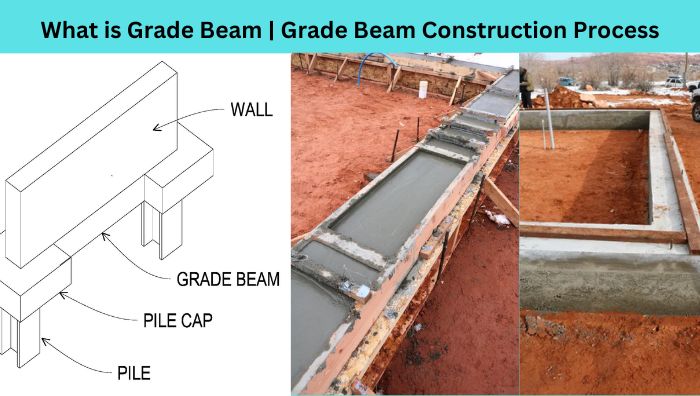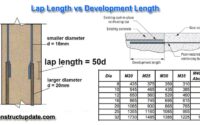What is Grade Beam | Grade Beam Foundation | Construction Process | Advantages and Disadvantages
What Is Grade Beam?
The purpose of a concrete beam sometimes called a grade beam, is to transfer the weight from the bearing wall into the spaced foundations. Caisson foundations or pile foundation toppings are typical examples.
It represents the portion of the building’s foundation made of RCC. It is continuously reinforced beyond the supported column and is fixed within the footing or foundation cap. according to ACI 318-14.
It is usually built as grade level spans or the ground between foundations to act as horizontal connectors between foundations. It aids in the prevention of uneven settlement.
The load of the building is distributed to the ground via its bases, while the grade beam footing aids in transferring the load to the ground or its supporting caps.

What is Grade Beam Foundation?
Underneath the outside walls, a grade beam foundation, also known as a perimeter beam foundation, is a rectangular-cross-section concrete foundation that runs around the perimeter of the home. Because it is a beam—a horizontal structural element—that rests at grade—the elevation of the ground—we refer to it as a grade beam. It works well with many natural building techniques even if it wasn’t formally constructed with natural materials.
A grade beam foundation can be constructed by an owner-builder (with little assistance) or by hiring any qualified contractor to do it for them. When compared to most traditional foundations, this style of foundation utilizes less concrete. A grade beam can be positioned on native soil in areas that are frost-free or have extremely shallow frost depths. You can still utilize a grade beam foundation if your building will be in an area with moderate to deep frost depths, but you may want to think about creating a rubble trench underneath it and/or adding insulation to make it a shallow foundation that is shielded from the frost.
Grade Beam Construction Process
The construction procedure of grade beams involves the following steps. The step-by-step instructions for building grade beams are provided here.
- Excavation and Preparation Process
- Installation Process of formwork for Grade Beam
- Reinforcement Placement Process
- Pouring concrete for grade beam
Excavation and Preparation Process
To build grade beams, trenches are dug out at the appropriate level. If we build it directly on the ground, the surface needs to be leveled and prepared first.
And if it is built between the foundation, excavation and preparation will take place after the piles are built.
However, where the grade beam has a footing cap installed, trench excavation will take place concurrently with footing installation.
To strengthen the grade beam, the ground’s surface needs to be leveled and prepared using PCC, or plain cement concrete.
Installation Process of formwork for Grade Beam
Following the excavation of the trench and the site, formwork preparation is placed in accordance with the measurements given in the drawing.
The bottom shutter will be installed earlier than the sides, which employ soling bricks in place of the bottom, if the grade beam is built on the ground.
Then, either one side of the shuttering can be installed first, followed by the reinforcement works, or the cage of reinforcement can be knotted on the level soiling brick surface before side shuttering is placed.
The formwork installation for a grade beam will be the same as for a conventional beam if the grade beam is constructed above ground.
Convenience and ease of construction are taken into consideration when choosing these building steps.
Once the formwork installation is complete, measure the grade beam with enough reinforcing cover to confirm the dimensions.
Reinforcement Placement Process
It’s time to install the beam reinforcement after the formwork is finished. The bars should be positioned in accordance with the structural drawing.
Structural drawings include important information about bars, including diameter, number of longitudinal reinforcements, stirrups bar diameter and spacing, and more bar specifications.
Check for lap length, reinforcement cover, hooks, etc., as indicated in the drawing, once the reinforcement is completed.
Concrete Pouring
Ready-mix concrete or concrete mixed on-site at the machine might be used for the grade beam casting. RMC is better if there is a lot of concrete.
The only requirement for the concrete provider is concrete strength if casting is done with ready-mix concrete. In contrast, the proportions of the elements in machine-mixed concrete must be chosen to guarantee the required level of strength.
Using a vibrator, ensure that the concrete is sufficiently compacted while pouring before finishing the upper surface.
After the concrete has been cast for 24 hours, the sides of the beam’s formwork can be removed, but the bottom shouldn’t be released until the concrete has strengthened. The length of the clear span determines how long it takes to remove the bottom form.
What are the advantages of Grade Beam?
The fact that grade beam foundations require less concrete than conventional foundations is a common reason for choosing them. This will lead to lesser embodied energy in the construction and less money spent on concrete.
Comparing this to a stem wall and footing:
In northern regions, a footing and stem wall with a crawl space or basement is the most typical conventional foundation. The fact that a grade beam requires only one pour, as opposed to several for the entire foundation, is another benefit it offers over this sort of foundation. (Usually, the stem wall is poured on top of the concrete footing once it has had time to set, and in the case of a basement, the slab is poured following.) Labor and time are saved by simply pouring once.
Comparing this to a slab on grade:
Slab on grade is the most typical conventional foundation in areas without frost. Pouring a grade beam takes less skill than pouring a slab. This is because the top surface that needs to be completed is much smaller and doesn’t require a flawless or even beautiful finish because the wall will hide it entirely.
Comparing this to a stone or block foundation:
Building foundation walls requires a lot of time and expertise; block foundations require less than stone foundations. Because a grade beam takes a lot less work and expertise, owner-builders can accomplish it more quickly and more easily.
Grade beam foundations are a desirable alternative due to their simplicity of construction and cost, labor, and time savings. Owner-builders can construct their foundation on their own because to the ease of construction.
What are the disadvantages of Grade Beam?
Basements cannot be built upon with grade beam foundations. For those who desire a basement in their home, this is a clear drawback. Another is that a level building site is necessary for grade beam foundations. Building on a hill will require extensive earthwork before beginning a grade beam foundation, or you may choose to select an other kind of foundation that can handle slopes.
Individuals who are worried about their home’s embodied energy or carbon footprint must balance the benefits of using less concrete against the drawbacks of a grade beam foundation, which still contains steel and concrete. Lastly, building inspectors may doubt this kind of foundation if they are unfamiliar with it. However, they might agree if you clarify that it’s essentially a footing without a stem wall. Hiring an engineer or architect to submit designs should work if they initially reject it; a building department will almost always accept stamped plans.




